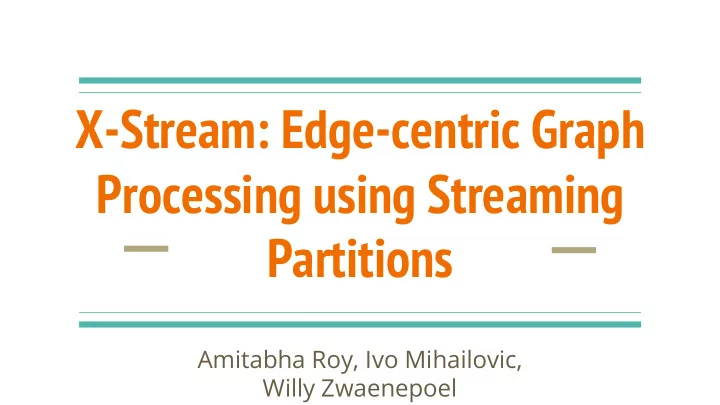

X-Stream: Edge-centric Graph Processing using Streaming Partitions Amitabha Roy, Ivo Mihailovic, Willy Zwaenepoel
Context Approach Model Implementation Results & Conclusion
Pregel & Powergraph: scatter & gather → A scatter-gather methodology: 1. scatter(vertex v): send updates over outgoing edges of v 2. gather(vertex v): apply updates from inbound edges of v → how to scale-up?
Trade-off: Sequential vs Random access
GraphChi: a sequential approach → avoids random access using shards Problems: 1. need graph to be pre-sorted by source vertex 2. vertex-centric 3. requires re-sort of edges by destination vertex for gather step
Context Approach Model Implementation Results & Conclusion
X-Stream’s Approach 1. retain scatter-gather programming model 2. use an edge-centric implementation 3. stream unordered edge lists Gains: 1. use sequential ( not random) access 2. do not need pre-processing step
scatter-gather : an edge-centric implementation scatter(edge e): send update over e gather(update u): apply update u to u.destination
Quick Terminology Fast Storage: → caches (in-memory) → main-memory (out-of-core) Slow Storage: → main-memory (in-memory) → SSD/Disk (out-of-core)
Context Approach Model Implementation Results & Conclusion
The basic model: input : an unordered set of directed edges Apply Scatter Apply Gather API : implementations of scatter/gather for given edges
Problem: vertices may not fit in fast storage
Problem: vertices may not fit in fast storage → Streaming partitions: - vertex set, V: a subset of the vertices of the graph - edge list: source is ∈ V - update list: dest ∈ V → How do we use them? 1. scatter/gather iterate over streaming partitions 2. updates need to be shuffled
Context Approach Model Implementation Results & Conclusion
Stream buffer Index Array (K entries) Chunck Chunck Array
Out-of-core In-memory → Folds shuffle into scatter → Parallel multi-stage shuffler & scatter/gather run scatter, appending updates to an in- stream independently for each ● ● memory buffer streaming partition when buffer full: run an in-memory work stealing ● ● shuffle group partitions together into a tree for ● the shuffler → 2 Stream Buffers → 3 stream buffers → Number of partitions → Number of partitions N/K + 5SK <= M = CPU_cache_size / footprint → Disk I/O
Chaos: the extension of X-Stream → Scale out to multiple machines in 1 cluster 2 gains: 1. access secondary storage in parallel improves performance 2. increases size of graph that can be handled
Chaos: the extension of X-Stream → Steps: 1. simple initial partitioning 2. spread graph data uniformly over all 2nd storage devices 3. work stealing Assumptions : 1. network machine-to-machine bandwidth > bandwidth of storage device 2. network switch bandwidth > aggregate bandwidth of all storage devices of cluster
Context Approach Model Implementation Results & Conclusion
Experiments: → Tested on real-world graphs.
Scalability
Comparison
Comparison: Ligra
Comparison: Graphchi
Conclusion & Takeaway Strengths : → Sequential access → Scale up & scale out Weaknesses → Limited number of problems it can handle → Limited types of graphs it can handle → How would you use in a real-world scenario
Recommend
More recommend